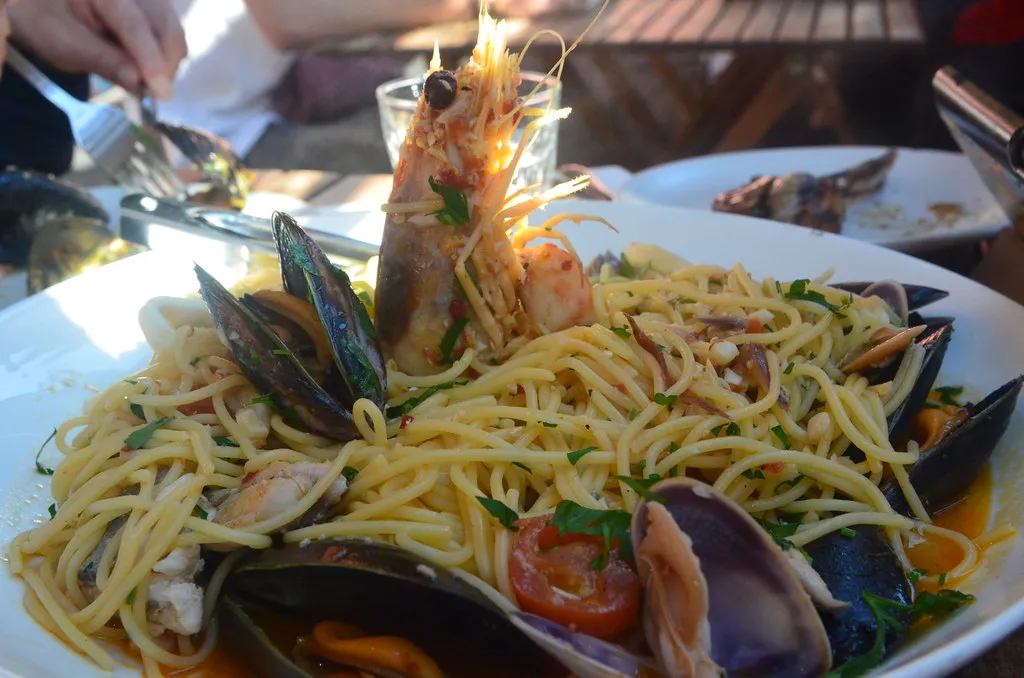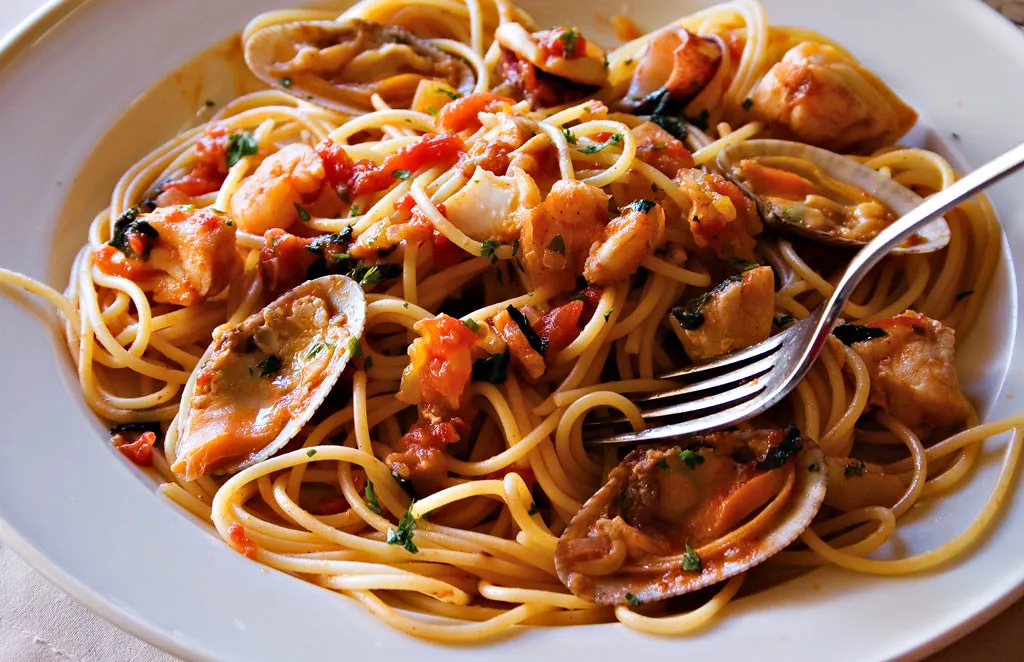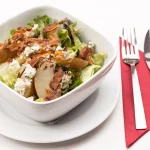The Best Fluffy Pancakes recipe you will fall in love with. Full of tips and tricks to help you make the best pancakes.
There’s something truly special about a plate of seafood spaghetti—a perfect combination of tender pasta, fresh seafood, and rich, flavorful sauce. Whether you’re a fan of shrimp, scallops, mussels, or a mix of everything, this dish brings the essence of the sea straight to your table.
Inspired by Italian and Mediterranean cuisine, seafood spaghetti is not only delicious but also surprisingly easy to make at home. With just a few key ingredients like garlic, olive oil, white wine, and fresh herbs, you can create a restaurant-quality meal in under an hour.
In this guide, we’ll walk you through the best seafood spaghetti recipe, complete with expert tips on selecting seafood, cooking pasta to perfection, and choosing the right sauce. Whether you prefer a tomato-based marinara, a creamy Alfredo, or a light lemon garlic butter sauce, there’s a variation for every taste.
Ready to elevate your pasta game? Let’s dive into this mouthwatering dish!
Why Seafood Spaghetti is a Must-Try Dish
Seafood spaghetti isn’t just another pasta dish—it’s a flavor-packed, elegant, and versatile meal that can be enjoyed on any occasion. Whether you’re looking for a quick weeknight dinner or an impressive meal for guests, this dish delivers a perfect balance of savory, fresh, and aromatic flavors. Here’s why you should add it to your must-try recipes.

1. The Perfect Balance of Seafood Flavors with Pasta
One of the greatest things about seafood spaghetti is how well the delicate, briny flavors of seafood complement the richness of pasta and sauce. The combination of succulent shrimp, tender scallops, and juicy mussels or clams creates a dish that is both light and satisfying. When tossed with a flavorful sauce—whether it’s a garlic butter sauce, marinara, or creamy Alfredo—it enhances the natural taste of the seafood, making every bite irresistible.
2. Versatile Ingredients to Suit Your Taste
Another reason seafood spaghetti is a must-try is its versatility. You can easily customize the dish based on your preferred seafood, sauce, and level of spice.
- Love shrimp? Make it a shrimp-only pasta.
- Want a more indulgent version? Add lobster or crab.
- Prefer a spicy kick? A dash of crushed red pepper or chili flakes does the trick.
- Need a dairy-free option? Stick with a simple lemon garlic olive oil sauce.
Whether you enjoy a classic Italian seafood marinara or a creamy seafood pasta, this dish can be adapted to fit your cravings and dietary preferences.
3. A Quick and Easy Meal for Any Occasion
Despite its fancy reputation, seafood spaghetti is surprisingly easy to make. Most versions come together in under an hour, making it a perfect option for weeknight dinners. It’s also a show-stopping dish for special occasions like date nights, dinner parties, or holiday feasts.
With a one-pan cooking method, minimal ingredients, and no complicated techniques, even beginner home cooks can make a restaurant-quality meal with ease.
4. A Nutritious and Wholesome Dish
Seafood spaghetti is not just delicious—it’s also nutritious. Seafood is a great source of lean protein, omega-3 fatty acids, vitamins, and minerals, making this dish a healthier alternative to heavy, meat-based pasta recipes. Plus, when paired with whole wheat spaghetti or gluten-free pasta, it becomes an even more balanced and nutritious meal.
Key Ingredients for the Perfect Seafood Spaghetti
The key to making perfect seafood spaghetti lies in selecting fresh, high-quality ingredients that complement each other to create a dish bursting with flavor. From choosing the right pasta to picking the best seafood and enhancing the dish with aromatic seasonings, every ingredient plays a crucial role in achieving a well-balanced and delicious meal.
1. Best Pasta Choices for Seafood Spaghetti
While spaghetti is the go-to choice for this dish, other pasta varieties can also work well depending on the texture and sauce you prefer.
- Spaghetti – The classic choice, perfect for soaking up light sauces and seafood juices.
- Linguine – Slightly wider than spaghetti, ideal for creamy or garlic butter sauces.
- Fettuccine – A great option for richer, cream-based seafood pasta dishes.
- Angel Hair – A delicate pasta that pairs well with lighter sauces but can be overwhelmed by heavy ingredients.
- Gluten-Free or Whole Wheat Pasta – A healthier alternative that still delivers great texture and taste.
Pro Tip: Cook your pasta al dente (slightly firm to the bite) to prevent it from getting mushy when combined with the seafood and sauce.
2. Seafood Selection: Choosing the Best Mix
The star of the dish is, of course, the seafood! Using fresh seafood enhances the dish’s taste, but frozen seafood can also work if properly thawed. Here are some excellent seafood choices:
- Shrimp – A must-have ingredient, offering a mildly sweet, tender bite that pairs beautifully with pasta.
- Scallops – Add a buttery, slightly sweet flavor and a delicate texture.
- Mussels & Clams – Provide a natural briny, ocean-like taste that deepens the dish’s flavor profile.
- Lobster or Crab – A luxurious addition that makes seafood spaghetti extra indulgent.
- Calamari (Squid) – Brings a chewy texture and a slightly sweet flavor to the dish.
Pro Tip: If using frozen seafood, let it thaw in the refrigerator overnight and pat dry before cooking to avoid excess water in your sauce.
3. Flavor Boosters: Essential Herbs and Seasonings
To enhance the natural flavors of the seafood and pasta, a mix of aromatic ingredients and seasonings is essential. Here’s what you’ll need:
- Garlic – A key ingredient that adds depth and aroma to the dish. Fresh minced garlic works best.
- Olive Oil – High-quality extra virgin olive oil is ideal for sautéing seafood and creating a flavorful base.
- White Wine – A splash of dry white wine (like Pinot Grigio or Sauvignon Blanc) adds brightness and complexity.
- Lemon Zest & Juice – Brings a fresh, citrusy kick that balances the richness of the seafood.
- Crushed Red Pepper (Chili Flakes) – A touch of heat enhances the dish’s depth without overpowering the seafood.
- Fresh Herbs (Parsley & Basil) – Chopped parsley adds freshness, while basil lends a sweet, peppery aroma.
- Salt & Black Pepper – Seasoning is crucial to bringing out the best flavors in the dish.
Pro Tip: Fresh herbs should be added at the end to preserve their flavor and brightness.
4. Sauce Options: The Heart of the Dish
The sauce ties everything together, so choosing the right one is key to creating a balanced seafood spaghetti. Here are the top options:
- Tomato-Based Marinara Sauce – A classic Italian-style sauce made with crushed tomatoes, garlic, olive oil, and herbs. It pairs well with all types of seafood.
- Garlic Butter & White Wine Sauce – A light yet flavorful sauce perfect for shrimp, scallops, and mussels.
- Creamy Alfredo or Parmesan Sauce – Ideal for those who love a rich, indulgent pasta dish with seafood.
- Lemon Garlic Olive Oil Sauce – A simple and refreshing choice for a lighter seafood spaghetti.
Pro Tip: If using a tomato-based sauce, let it simmer for at least 10 minutes to develop a deep, rich flavor before adding seafood.
5. Cheese & Garnishes: The Finishing Touches
Although traditional Italian seafood pasta avoids cheese, many people enjoy a light dusting of cheese for extra flavor.
- Parmesan Cheese – Adds a slightly salty, nutty touch to the dish.
- Pecorino Romano – A sharper alternative to Parmesan, great for bold flavors.
- Lemon Wedges – Served on the side for extra freshness.
- Fresh Parsley or Basil – A final sprinkle of herbs enhances presentation and taste.
Step-by-Step Guide to Cooking Seafood Spaghetti
Making seafood spaghetti at home may seem intimidating, but with the right approach, you can achieve restaurant-quality results with minimal effort. Follow this step-by-step guide to create a delicious and perfectly balanced seafood pasta dish.
1. Gather and Prepare Your Ingredients
Before you start cooking, it’s essential to have all your ingredients prepped and ready to ensure a smooth cooking process.
Ingredients Checklist:
- Spaghetti (or linguine, fettuccine, etc.) – 12 oz
- Seafood of choice (shrimp, scallops, mussels, clams, squid, etc.) – 1 lb
- Garlic (minced) – 4 cloves
- Olive oil (extra virgin) – 3 tbsp
- Dry white wine (Pinot Grigio, Sauvignon Blanc, or Chardonnay) – ½ cup
- Lemon juice & zest – From 1 lemon
- Crushed red pepper flakes – ½ tsp (optional, for spice)
- Fresh parsley (chopped) – ¼ cup
- Tomatoes (diced or crushed, if making a marinara-based sauce) – 1 can (14 oz)
- Butter – 2 tbsp (optional, for a richer sauce)
- Salt & black pepper – To taste
Seafood Preparation:
- If using fresh seafood, rinse and pat dry with a paper towel.
- For frozen seafood, thaw overnight in the refrigerator or quickly defrost in a bowl of cold water.
- Remove shells from shrimp, scrub and de-beard mussels and clams, and slice calamari into rings.
Pro Tip: If using mussels or clams, discard any that remain open before cooking and after steaming.
2. Cook the Pasta to Perfection
Cooking the pasta correctly ensures the best texture and flavor for your seafood spaghetti.
Steps for Cooking Pasta:
- Bring a large pot of salted water to a rolling boil.
- Add the pasta and cook until al dente, following package instructions (usually 8-10 minutes).
- Reserve ½ cup of pasta water before draining the pasta. This can be used later to adjust the sauce consistency.
- Drain and toss with a little olive oil to prevent sticking while you prepare the seafood.
Pro Tip: Cooking pasta al dente helps it absorb the sauce better without becoming too soft.
To achieve the perfect sear on your seafood without sticking, using a high-quality, non-stick pan is essential. The Ninja NeverStick Fry Pan is an excellent choice, offering superior heat retention, even cooking, and a durable non-stick coating that can withstand high temperatures. This ensures your seafood remains tender and flavorful while cooking.
3. Sauté the Aromatics and Cook the Seafood
This is where the magic happens—infusing the dish with incredible flavors.
Steps for Cooking the Seafood:
- Heat 2 tbsp of olive oil in a large skillet or pan over medium heat.
- Add the minced garlic and crushed red pepper flakes (if using) and sauté for about 30 seconds, until fragrant.
- Add the shrimp and scallops, cooking for 2-3 minutes per side until they turn opaque and slightly golden.
- If using mussels or clams, add them next along with ½ cup of white wine, then cover the pan and allow them to steam for about 5 minutes or until they open. (Discard any that remain closed.)
- Remove the cooked seafood from the pan and set aside to prevent overcooking.
Pro Tip: Cook seafood in batches if necessary, to ensure even cooking and avoid overcrowding the pan.
4. Make the Sauce
The sauce is what brings everything together, whether you prefer a light garlic butter sauce, a rich creamy sauce, or a classic tomato-based marinara.
Garlic Butter & White Wine Sauce:
- In the same pan where you cooked the seafood, add 2 more tbsp of olive oil or butter.
- Pour in the white wine and let it reduce for 2-3 minutes to intensify the flavor.
- Stir in the lemon juice and zest, and season with salt and pepper to taste.
- Add ½ cup of reserved pasta water if the sauce needs more liquid.
Tomato-Based Marinara Sauce:
- After cooking the seafood, add 1 can (14 oz) of crushed tomatoes to the pan.
- Stir in ½ tsp of dried oregano and basil, along with salt and black pepper.
- Let the sauce simmer for 10 minutes before adding the seafood back.
Creamy Alfredo-Style Sauce:
- Instead of white wine, add 1 cup of heavy cream to the pan.
- Stir in ½ cup of grated Parmesan cheese, letting it melt into the sauce.
- Add ½ tsp of nutmeg (optional) for extra depth.
Pro Tip: If your sauce feels too thick, add a splash of reserved pasta water to loosen it up.
5. Combine Everything and Serve
Now it’s time to bring everything together for a perfect plate of seafood spaghetti!
Final Steps:
- Return the cooked seafood to the pan and gently toss it in the sauce.
- Add the drained spaghetti, tossing everything together so the pasta absorbs the flavors.
- Let everything cook for 1-2 minutes to allow the sauce to coat the pasta evenly.
- Taste and adjust seasoning as needed (adding more salt, pepper, or lemon juice).
- Remove from heat and garnish with fresh chopped parsley and a sprinkle of Parmesan cheese (if desired).
Pro Tip: Let the pasta sit in the sauce for a minute or two before serving to help the flavors meld together.
Serving Suggestions & Pairings
Now that your seafood spaghetti is ready, enhance the meal with complementary sides and drinks:
- Garlic Bread or Bruschetta – Perfect for soaking up extra sauce.
- A Fresh Green Salad – A simple arugula or Caesar salad adds a crisp contrast.
- White Wine Pairing – Serve with a dry white wine like Pinot Grigio, Sauvignon Blanc, or Chardonnay.
- Lemon Wedges on the Side – A squeeze of fresh lemon enhances the seafood’s natural flavors.
Pro Tips for the Best Seafood Spaghetti
Creating perfect seafood spaghetti requires more than just following a recipe—it’s about understanding the nuances of ingredients, technique, and flavor balance. Here are some expert tips to take your dish from good to restaurant-quality!

Choose the Right Pasta for the Best Texture
Not all pasta shapes are created equal when it comes to seafood spaghetti. The type of pasta you choose can significantly impact the dish’s texture and how well it holds the sauce.
Best choices:
- Spaghetti: The classic choice, perfect for light seafood sauces.
- Linguine or Fettuccine: Slightly thicker, great for holding creamy or tomato-based sauces.
- Angel Hair (Capellini): A delicate option that works well with light oil-based or lemon butter sauces.
Avoid overly thick pasta like rigatoni or penne, as they may overpower the delicate seafood flavors.
Use Fresh, High-Quality Seafood
The quality of your seafood is the most important factor in making an outstanding dish.
Fresh vs. frozen seafood:
- Fresh seafood is ideal, but if unavailable, frozen seafood can work well—just make sure to thaw it properly before cooking.
- Avoid pre-cooked seafood, as it can become rubbery when reheated.
How to spot fresh seafood:
- Shrimp & Scallops: Should be firm, slightly translucent, and smell like the ocean (not fishy).
- Mussels & Clams: Buy them alive—they should close when lightly tapped.
- Squid: Should be bright white and firm, with no strong odor.
If using frozen seafood, thaw it overnight in the fridge or place it in a sealed bag under cold running water for a quicker method.
Cook Seafood Correctly to Avoid Overcooking
Seafood cooks very quickly, and overcooking can lead to rubbery shrimp, tough scallops, or chewy squid.
General cooking times for seafood:
- Shrimp & Scallops: 2-3 minutes per side (turn opaque and slightly golden)
- Mussels & Clams: 5-7 minutes (should open fully)
- Squid (Calamari): 1-2 minutes max (either quick sear or long slow cook; in-between makes it tough)
Remove seafood from the pan once cooked and add it back at the end to prevent overcooking.
Use Reserved Pasta Water for a Silky Sauce
One of the secrets to a rich, restaurant-style sauce is pasta water. The starch in the water helps emulsify and thicken the sauce, allowing it to cling beautifully to the pasta.
How to use pasta water:
- Before draining the pasta, save about ½ cup of the starchy water.
- Gradually add it to your sauce while tossing the pasta, adjusting until you get the desired consistency.
Don’t rinse the pasta after draining. The starch on the noodles helps the sauce stick better.
Balance the Flavors with Acid and Heat
Seafood spaghetti is all about balance—rich flavors need brightness, and mild flavors need a kick.
Ways to balance your dish:
- Lemon Zest & Juice: Enhances freshness and prevents the dish from feeling too heavy.
- White Wine: Adds depth and cuts through richness (choose dry wines like Pinot Grigio or Sauvignon Blanc).
- Crushed Red Pepper Flakes: Brings subtle heat without overpowering the seafood.
- Fresh Herbs: Parsley, basil, or oregano add freshness.
Add lemon juice at the end to preserve its bright, fresh taste.
Let the Pasta Rest Before Serving
Once you’ve combined the pasta with the seafood and sauce, let it sit for a minute or two before serving. This brief resting time allows the pasta to absorb more sauce and develop deeper flavors.
If your pasta looks dry, add a little extra olive oil or reserved pasta water to bring back the shine.
Pair with the Right Side Dishes & Wine
Enhance your seafood spaghetti by serving it with complementary sides and drinks.
Best side dishes:
- Garlic Bread or Bruschetta – Perfect for soaking up extra sauce.
- A Fresh Salad – Light greens like arugula or a classic Caesar salad add crisp contrast.
- Steamed or Roasted Vegetables – Asparagus, zucchini, or cherry tomatoes pair beautifully.
Wine pairings:
- White Wine: Sauvignon Blanc, Pinot Grigio, or Chardonnay
- Rosé: A dry rosé complements seafood’s delicate flavors
- Light Red Wine: Pinot Noir (if using a tomato-based sauce)
Delicious Variations of Seafood Spaghetti
Seafood spaghetti is a versatile dish that can be customized in many ways to suit different tastes and preferences. Whether you enjoy a light and fresh version or a rich and creamy sauce, there are endless possibilities to explore. Below are some delicious variations that highlight different flavors, ingredients, and cooking styles.

Classic Italian-Style Seafood Spaghetti
This traditional version is inspired by Italian coastal cuisine and features a simple yet flavorful sauce that lets the seafood shine.
Key ingredients:
- Olive oil, garlic, and chili flakes for a light base
- Fresh tomatoes or canned San Marzano tomatoes for a rich yet fresh sauce
- A mix of shrimp, mussels, clams, and squid
- White wine and fresh parsley for balance
Cooking tip: Lightly sauté the seafood with garlic and chili flakes before adding tomatoes and white wine. Simmer gently to develop flavors without overcooking the seafood.
Creamy Seafood Spaghetti
For those who love a rich and indulgent pasta dish, a creamy seafood spaghetti variation is a perfect choice.
Key ingredients:
- Heavy cream or half-and-half for a velvety sauce
- Parmesan cheese for depth of flavor
- Shrimp and scallops for a delicate, buttery texture
- Garlic, butter, and a touch of nutmeg for added warmth
Cooking tip: Cook the seafood separately and add it back to the creamy sauce at the end to prevent overcooking. A squeeze of lemon helps balance the richness.
Spicy Seafood Spaghetti (Fra Diavolo Style)
If you enjoy bold flavors with a little heat, this spicy version is a must-try. Inspired by the Italian-American Fra Diavolo sauce, it brings a fiery kick to the dish.
Key ingredients:
- Crushed red pepper flakes or fresh chili peppers for heat
- A tomato-based sauce with garlic and onion
- Shrimp and lobster for a luxurious touch
- White wine or a splash of brandy for extra depth
Cooking tip: Adjust the spice level by adding more or less chili flakes. Serve with fresh basil to contrast the heat with a hint of sweetness.
Lemon Garlic Seafood Spaghetti
A bright and refreshing option, this version focuses on zesty citrus and fresh garlic flavors.
Key ingredients:
- Olive oil and butter for a balanced base
- Lots of fresh garlic for aroma and depth
- Lemon zest and juice for a vibrant, tangy finish
- Shrimp and calamari for a quick-cooking protein
Cooking tip: Add the lemon juice at the very end to preserve its fresh, citrusy taste. Serve with a sprinkle of grated Parmesan or Pecorino Romano for a salty contrast.
Mediterranean-Style Seafood Spaghetti
This variation brings together bold Mediterranean flavors, combining seafood with olives, capers, and sun-dried tomatoes.
Key ingredients:
- Kalamata olives and capers for a salty, briny contrast
- Cherry tomatoes and sun-dried tomatoes for sweetness and depth
- White fish, shrimp, and mussels for a mix of textures
- Fresh herbs like basil, oregano, and parsley
Cooking tip: Let the sauce simmer gently to allow all the flavors to blend together. Drizzle with extra virgin olive oil before serving for an authentic Mediterranean touch.
If you’re looking to explore other pasta dishes with a unique twist, you might also enjoy Easy Dominican Spaghetti: A Quick and Flavorful Meal, which brings a delicious Caribbean influence to traditional spaghetti. This flavorful variation combines tomatoes, spices, and a rich sauce for a hearty meal that pairs perfectly with seafood or can stand alone for a quick dinner.






[…] If you enjoy fresh seafood, you might also love our : The Best Seafood Spaghetti Recipe for Pasta Lovers […]
[…] starter to awaken the palate, but it’s equally delightful as a side dish alongside grilled meats, seafood, or pasta. You can also include it as part of an antipasto platter, paired with cured meats like […]